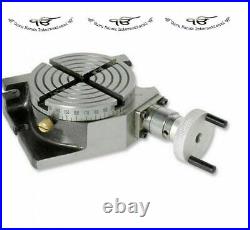Rotary Table 4 Inch/100mm Horizontal Vertical For Milling Premium




Rotary table 4 inch 100 mm horizontal-vertical model milling machine 4 slots. The Metal: High quality 18 gauge iron steel with brass accents. THIS NICE LITTLE 100MM DIAMETER ROTARY TABLE CAN BE USED FOR A VARIETY OF MILLING, DRILLING AND MARKING JOBS IN THE HOME TECHNICIAN’S WORKSHOP. THERE ARE FOUR T-SLOTS FOR SECURING THE WORK, RIGHT-ANGLE MACHINED SURFACES FOR HORIZONTAL AND VERTICAL MOUNTING, AND 7MM SLOTS FOR SECURING TO THE MACHINE TABLE. THE INDEXING HANDLE, WHICH ROTATES ONCE FOR PER TEN DEGREES OF TABLE ROTATION, IS DIVIDED INTO DEGREES AND QUARTER DEGREES. THE CENTER HEIGHT FOR VERTICAL MOUNTING IS 40 MM. SUPPLIED WITH WORKING CLAMP KIT. VERTICAL AND HORIZONTAL MOUNTING TEE SLOTS TO SECURE WORK WHEEL MARKED WITH DEGREES AND QUARTER DEGREES. A precision workpiece positioning device used in metalworking that allows the operator to drill or cut workpieces at precise intervals around a fixed axis. Rotary tables are most commonly mounted “flat” where the table rotates about a vertical axis in the same plane as the cutter on a vertical milling machine. An alternative setup is to mount the turntable at its end (or mount “flat” on a 90° angle plate) so that it rotates about a horizontal axis. A tailstock that holds the workpiece “between the centers” can also be used in this configuration. Horizontal/vertical rotary tables are an extremely useful accessory for a milling machine. Milling curved profiles and angled surfaces relative to a centerline. Drilling or milling on polar coordinates and with vertical mounting with tailstock for machining shafts or spindles. The versatile units can also be used on drilling, boring or slotting machines, allowing for an even wider range of operations. Machining – To set the initial workpiece position, simply loosen the zero collar locking handle and rotate the zero collar approximately half a turn counterclockwise. The worm is now separated from the worm wheel drive, the table can rotate independently of the hand crank and the workpiece can now be precisely aligned. To re-lock, simply turn the zero ring clockwise and retighten the locking handle. For machining wrench surfaces on a screw. For drilling equidistant holes on a circular flange. To cut a round piece with a protruding tang. For creating large diameter holes by milling in a circular toolpath on small milling machines that do not have the power to drive large twist drills (>0.500/>13mm). How to Cut Complex Curves (With Proper Setup). For cutting straight lines at any angle.

